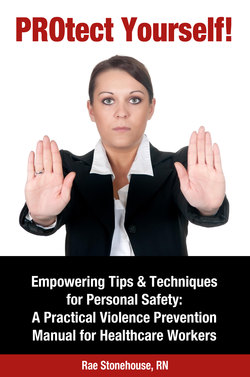Читать книгу PROtect Yourself! Empowering Tips & Techniques for Personal Safety: A Practical Violence Prevention Manual for Healthcare Workers - Rae Stonehouse - Страница 18
На сайте Литреса книга снята с продажи.
Diagnosis: Cognitive Impairment:
ОглавлениеReversible: Examples of causes: delirium or acute confusional state related to fluid and electrolyte imbalance; medication side effects; infection; trauma; certain types of head injuries; psychiatric disorder; substance use (alcohol, drugs); history of post-traumatic stress disorder; by anaesthetic/analgesia for pain management
Criteria: Increase in motor agitation
Behavior:
•pacing
•inability to sit still
•sudden cessation of motor activity
Comment: These are attempts to discharge aggression via large muscle activity. This can easily escalate into acting out behavior.
Criteria: Threatening verbalizations or gestures toward real or imagined objects
Behavior:
•retaliation toward actual persons who are seen as threats
•aggressiveness in response to threatening visual or auditory hallucinations
•aggressiveness in response to expansion of delusional thinking
•dementia causes a decline in all areas of mental ability, including a person’s understanding of is going on around them
Comment: Such hallucinations are bizarre, threatening, unfamiliar, or confusing. Many psychotic individuals do live comfortably with an entourage of familiar “voices.”
The degree of violence is related to how desperately client perceives the need to protect the self. Because there may be no obvious connection between the cause of the patient’s anger and the resulting violent incident, workers may see the patient’s behaviour as completely unprovoked.
Criteria: Intensification of affect
Behavior:
•very tense expression
•jumpiness
•elated expression
Comment: Such intensification indicates loss of control, especially if accompanied by laughing.
Criteria: Alcohol & drug abuse and withdrawal
Behavior:
•intoxication with drugs or alcohol
•withdrawal from drugs or alcohol
Comment: The need to provide care to substance abusers, and the widespread awareness that medications such as opiates are available in health care facilities contribute to violence.
Chemically dependent clients present risk while intoxicated or in withdrawal stages. The transition period is of high risk for violence. The client can act out rage with their inhibitions dissolved from either intoxication or withdrawal from drugs and/or alcohol. Violence is due to irritability of the central nervous system. There can be neurological damage to the cerebral cortex. The anxiety, suspicion, and sense of helplessness that comes with being in a hospital or treatment centre, as well as the distress caused by the detoxification or treatment itself, can cause clients to become aggressive towards workers.
Withdrawal will be difficult to detect if you are unaware that the client has a chemical dependency problem. Some research would indicate that up to 30% of admissions to acute care facilities have a chemical dependency problem as a secondary diagnosis.
Additional Assessment Criteria:
In addition to formal screening devices, consider the following general indicators which may point to a dependency problem:
•Smell of alcohol on breath or person
•Flushed face, blood shot eyes, bulbous nose, or facial telangiectasia (small red spider veins radiating about a center core)
•Dilated or constricted pupils
•General appearance: poor hygiene, disheveled
•Intoxicated visitors
•Is patient confused, restless, defensive, hypersensitive, anxious to leave hospital, impulsive or rebellious?
•Signs of depression: any past suicide attempts?
•Poor employment record
•No fixed address or frequent address changes
•Weekend partner: someone with a penchant for chemically fueled social experiences
•Check old charts/clinical records for frequent emergency visits, medications, broken bones, prior laboratory indicators
•Lifestyle habits
•Impaired charges or roadside suspensions
•Smoker
•Unhealthy looking due to lifestyles: too thin or overweight
Many healthcare facilities have integrated this questionnaire into the nursing assessment forms.
CAGE has proven to be a reliable tool for preliminary assessment.
C Do you ever feel you ought to CUT down on your drinking?
A Do you ever feel ANGRY or ANNOYED if somebody comments or questions you about your drinking?
G Do you ever feel GUILTY about your use of alcohol, or how you behaved under the influence?
E EYEOPENER Do you take a drug or drink first thing in the morning to steady nerves or get rid of a hangover?
One affirmative response indicates that further assessment is required.
With two positives, an 80% likelihood of dependency exists and with three positives, there is a 99% chance the patient is chemically dependent.
